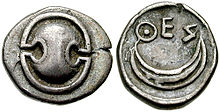
Back Теспия Bulgarian Tèspies Catalan Thespiae Welsh Thespiai German Θεσπιές Greek Tespias Spanish Tespias Basque Thespiai Finnish Thespies French An Teispiae Irish
Θεσπιαί | |
 Silver Obol from Thespiae, 431-424 BCE. Obverse: Boeotian shield. Reverse: crescent, ΘΕΣ[ΠΙΕΩΝ] (of the Thespians). | |
| Coordinates | 38°17′36″N 23°09′04″E / 38.29333°N 23.15111°E |
|---|---|
| Type | Ancient city |
| History | |
| Founded | Before c. 750 BCE |
| Periods | Archaic, Classical, Hellenistic, Roman |
| Cultures | Ancient Greek |
| Site notes | |
| Excavation dates | 1882 |
| Archaeologists | Panagiotis Stamatakis |
| Condition | Ruined |
Thespiae (/ˈθɛspi.iː/ THESP-ee-ee; Ancient Greek: Θεσπιαί, romanized: Thespiaí) was an ancient Greek city (polis) in Boeotia. It stood on level ground commanded by the low range of hills which run eastward from the foot of Mount Helicon to Thebes, near modern Thespies.[1]
During the Second Persian invasion of Greece, Thespiae's 700 hoplites remained with the Spartans in the Battle of Thermopylae, fighting the Persians and allowing the Greek forces to retreat. It was one of the few Boeotian cities to stay loyal to Greece after the battle.[2] Although Thespian hoplites are popularly depicted with dark cloaks and crescent shields, no evidence supports the historical accuracy of these items.[3] In Ancient Greece, Thespiae rivaled Thebes and survived through the Roman Empire.[2]
- ^ Chisholm 1911.
- ^ a b "Thespiae". Encyclopædia Britannica. Aug 1, 2020. Retrieved April 19, 2024.
- ^ Markloulakis, Nikolaos (2007-10-27). "What the Thespian hoplites looked like?". Sparta: Journal of Ancient Spartan and Greek History. Archived from the original on 2016-03-04.
